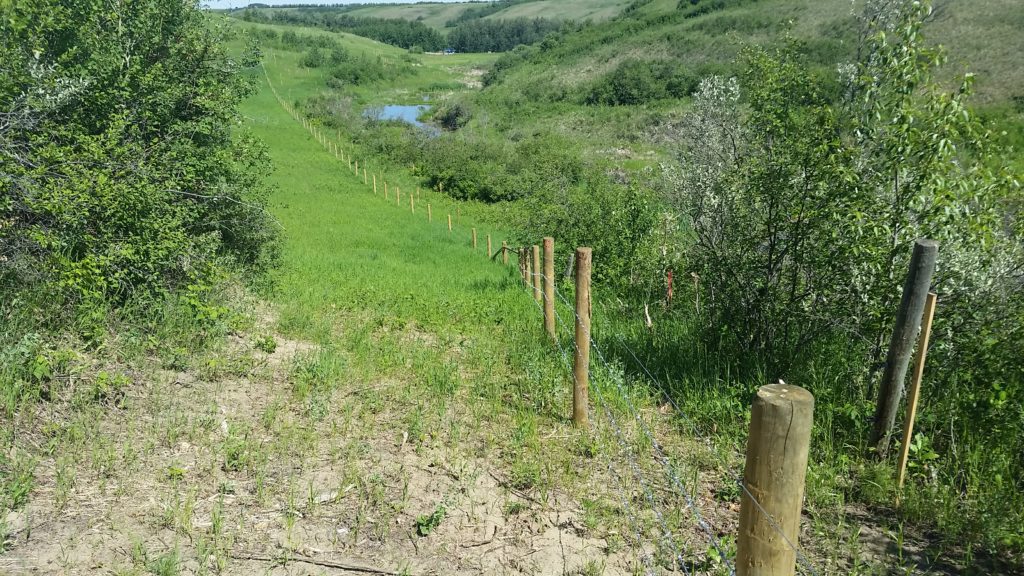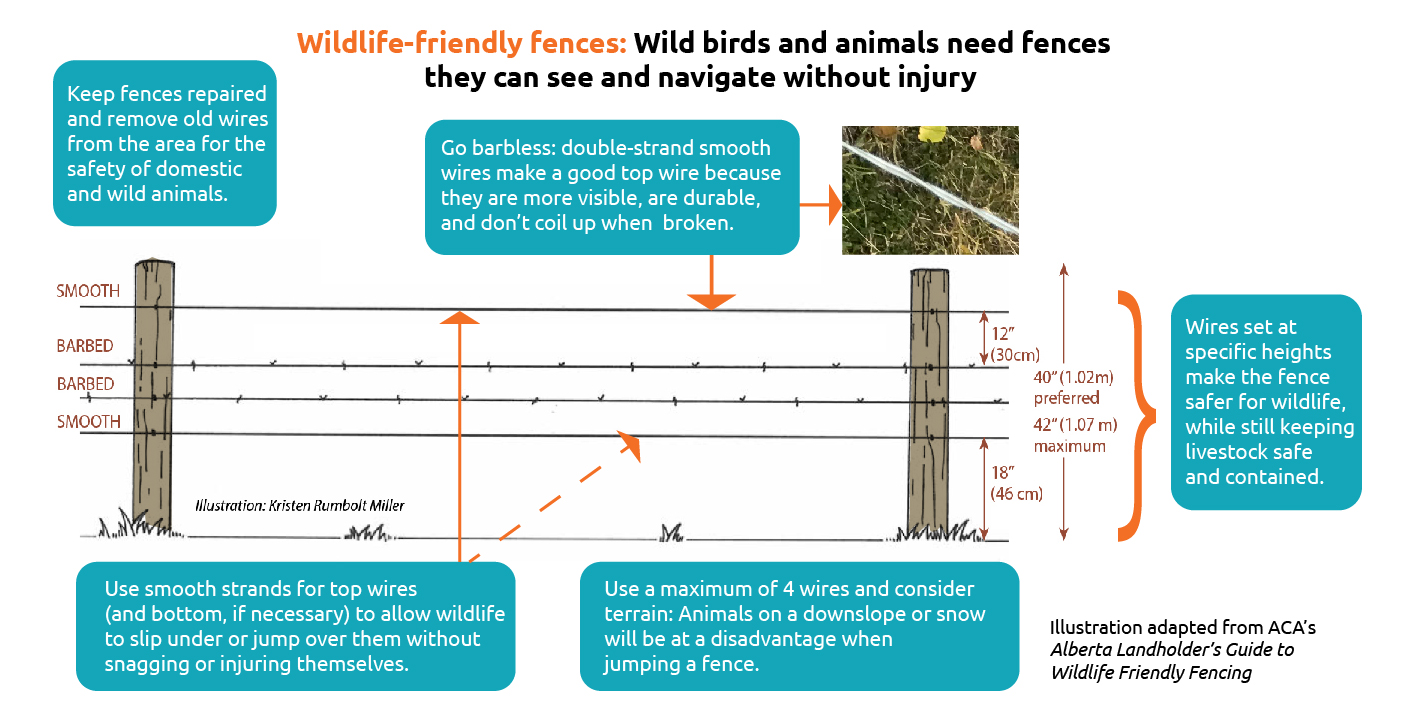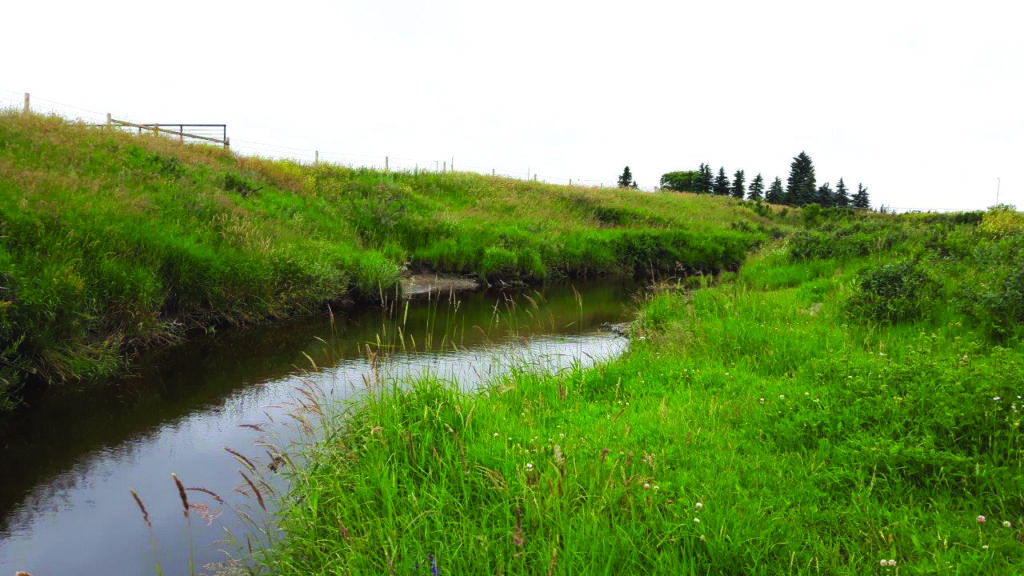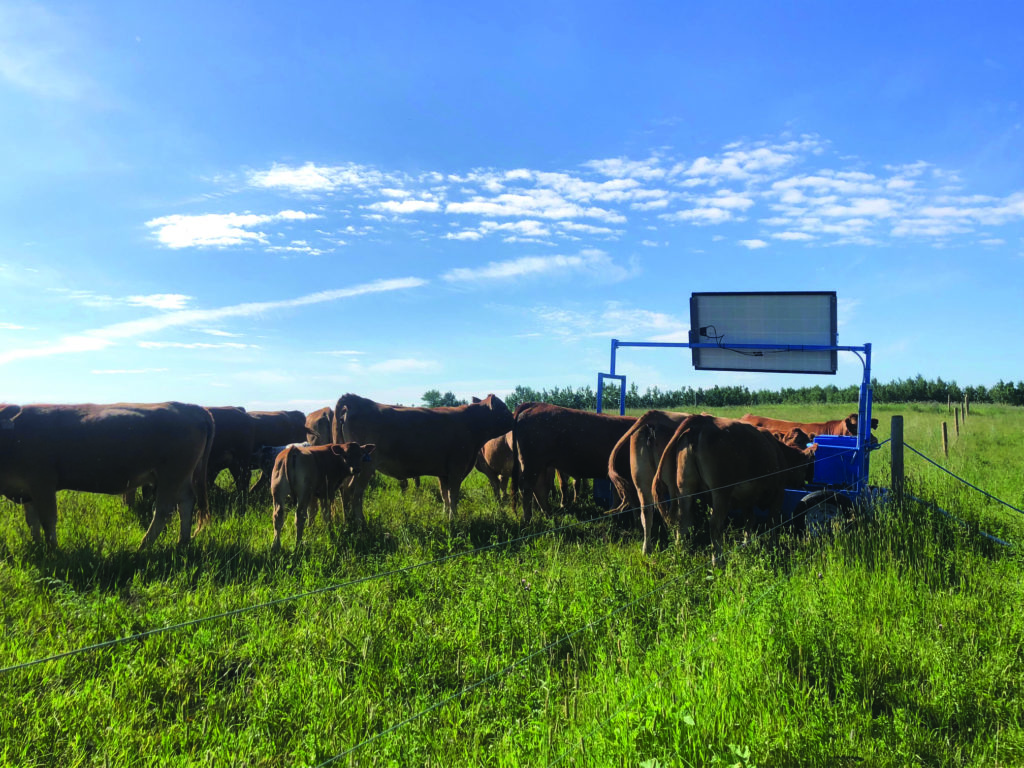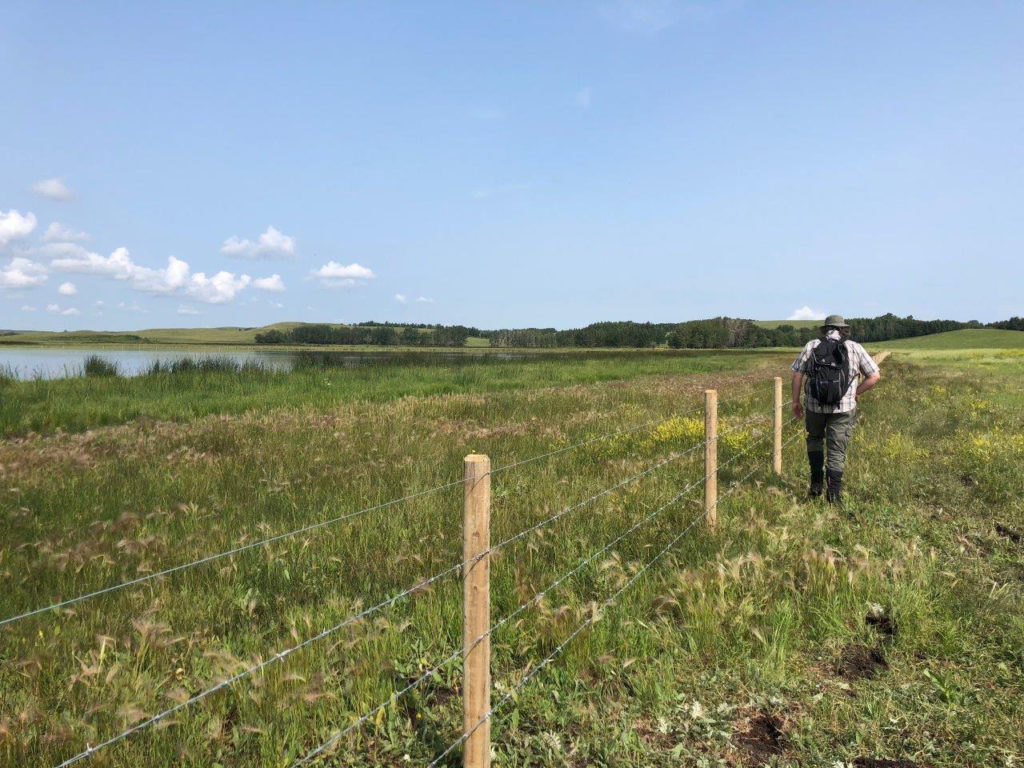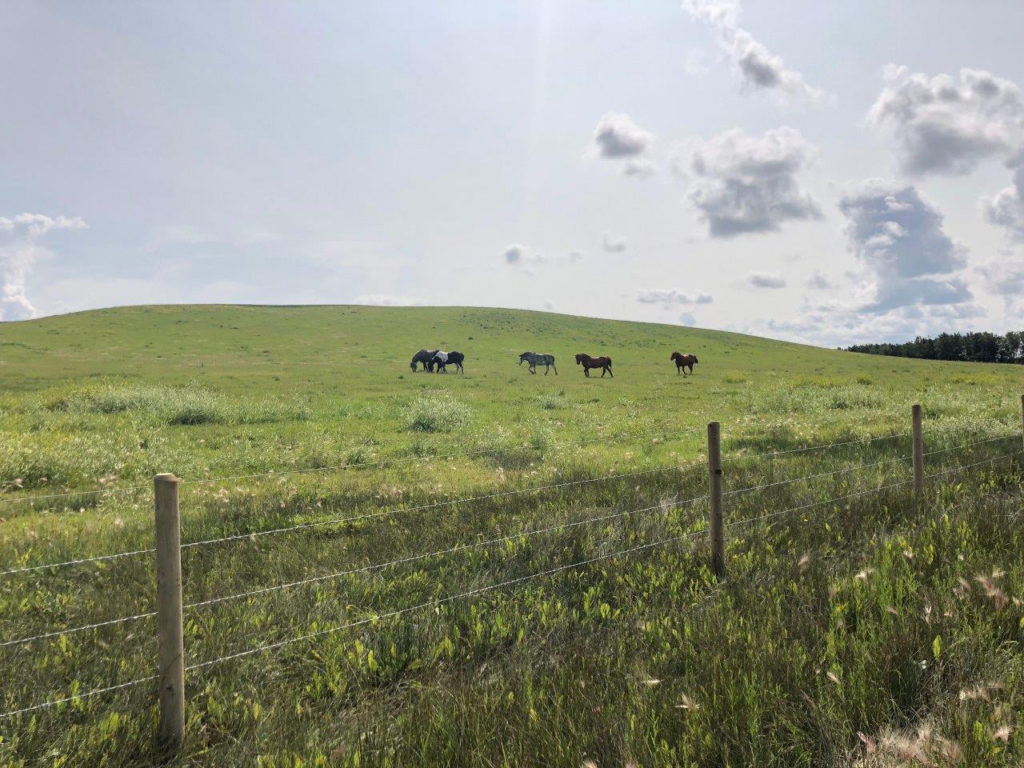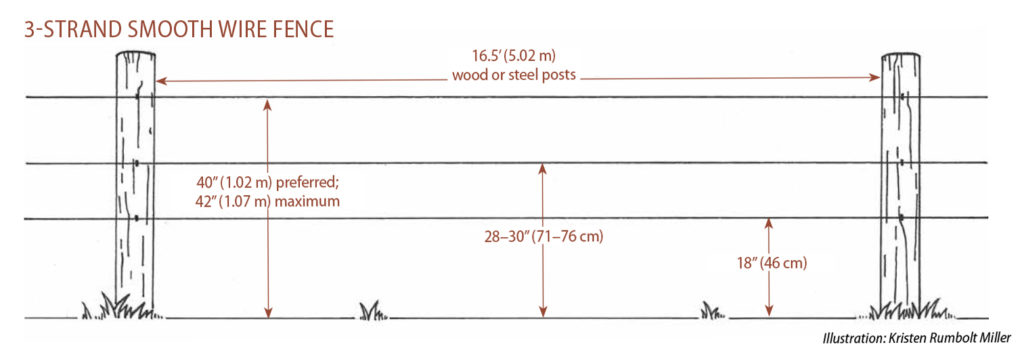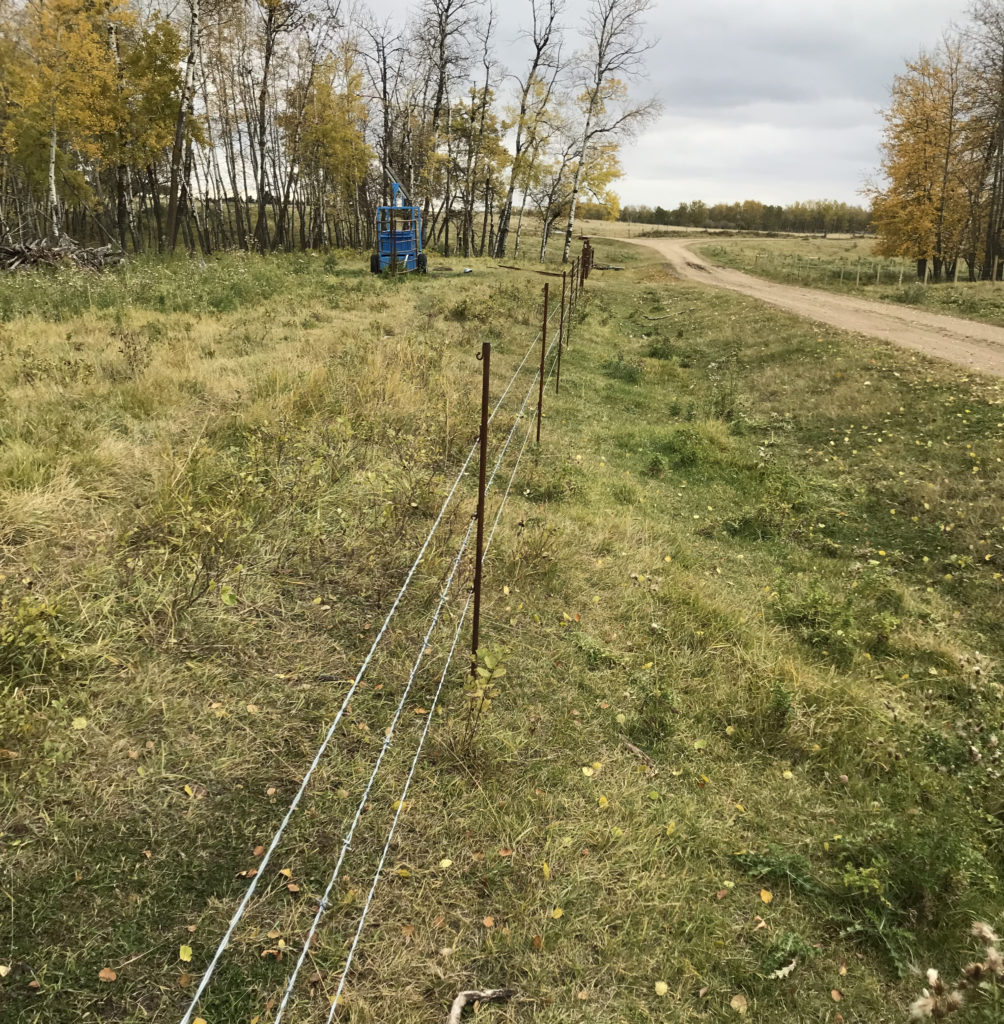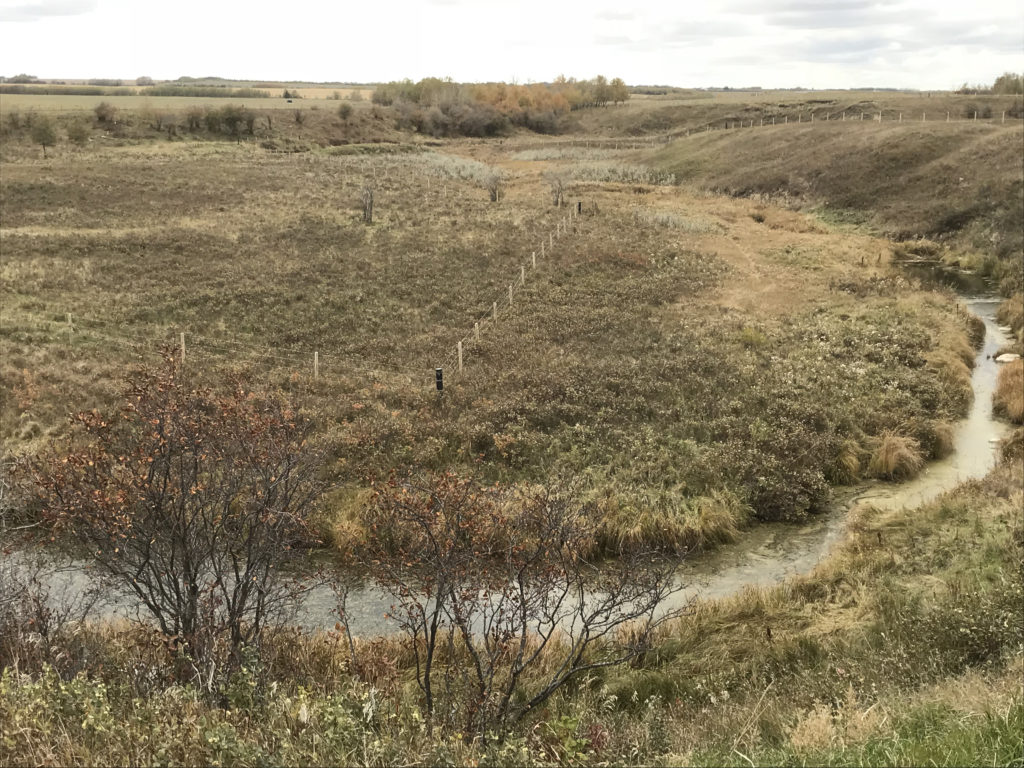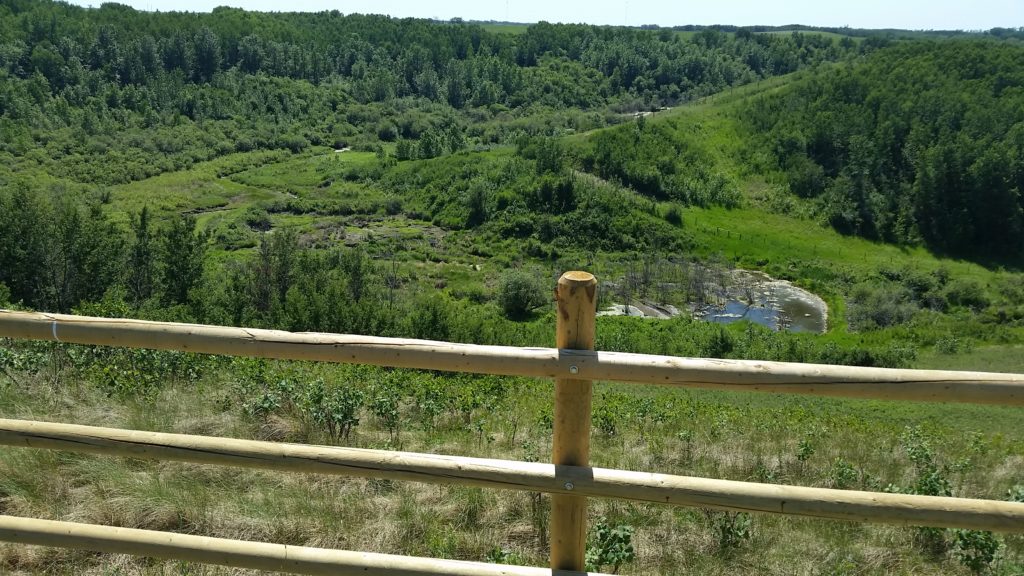“Do Fence Me In!” Fencing with Water and Wildlife in Mind
Written by Heather J. Marshall
Fences serve an important purpose for landowners and farmers. They are used to:
- Mark property boundaries
- Hold livestock (read more about livestock legislation under the Stray Animals Act)
- Practice rotational grazing
- Protect stream banks and vegetation from livestock overgrazing
- Allow nature to recover through native plant seed banks or roots
- Indirectly control flooding and soil erosion and help filter water through riparian vegetation
Photo: Chris Elder.
Things to consider before you begin fencing:
- Purpose of the fence: Do you want to exclude or contain livestock (cattle, sheep, horse or combination), stop trespassers, protect riparian areas or areas in need of recovery?
- Wildlife movement and patterns: What wildlife live and move through your area and are there corridors (or trails) which are already used for water or habitat? Sections of fence that always need repairing due to wildlife movement may be a good place to put a gate or wildlife-friendly fencing.
- Topography: Is your land flat, sloped or uneven? What type of posts or stakes can be driven into your soil? Would fences pass near or through water? How can your design avoid snaring or creating barriers for wildlife?
- Type of Fence: What type of fence will work best for the location and how much longevity or maintenance will different options require? Read more in the Types of Fences section below.
Wildlife & Fences:
Wildlife need access to water and riparian areas for foraging and habitat, so it is important to allow some access point to water and surrounding vegetation. There are some simple and inexpensive ways to keep wildlife moving through your property safely, but still prevent fence damage, and contain your livestock. General guidelines:
-
- Use exclusion fencing only when necessary to protect vegetation or sensitive areas
- Leave gates open when livestock are not using fenced in areas (e.g. winter or when using other sections of your land)
- Only keep fence electrified when in use
- Avoid fences that form a complete barrier as wildlife and birds can injure themselves trying to get through or past them
If you want to make your existing barbed wire fences safer for wildlife, you can add visibility markers, flags or PVC pipe. See diagram below. Go to pages 12-13 of the Alberta Landholder’s Guide to Wildlife Friendly Fencing for some DIY ideas and more information.
Illustration adapted from ACA’s Alberta Landholder’s Guide to Wildlife Friendly Fencing.
Fencing in the Riparian Zone:
When thinking of how to work with your riparian zone, you may want to make your riparian area a separate pasture, with its own objectives and strategies. Consider these guidelines and tips:
- Manage grazing in riparian areas in less critical seasons (avoid early spring for waterfowl and frog breeding season and fall bird migrations)
- Fence off areas near water to prevent foot rot for livestock and better weight gains as they access cleaner drinking water
- Fence riparian buffers far back enough so that there will be less maintenance from flood damage and reduce the corners or meanders
- Try to fence like-with-like types of plant communities (i.e. fence riparian separately from uplands, if possible)
- Draw livestock away from riparian areas by placing attractants (off-stream waterers, salt, minerals, rubbing posts and shady places) in upland areas
- Minimize impacts when creating stream crossings and access points
- banks and grade of the crossing should be stable
- should not interfere with the water’s flow or aquatic life
- Protect or restore the water source or wetland you have because it’s easier than creating a new one
- Consider whether exclusion or corridor fencing is the only way to deal with overgrazed riparian areas
- Ask an expert! Get project advice from your local reps from ALUS, AWES or Cows and Fish. They will also be able to advise you about possible funding for your project.
By fencing off the riparian area on both sides of the Vermilion River, this farmer improved bank stability, reduced soil compaction, improved water quality, and encouraged riparian plant recovery. Photo: NSWA/VRWA.
Using Fences for Rotational Grazing
Proper fencing distributes livestock more evenly and evens out the grazing load over the whole landscape.
- Use cross/internal fences or electric fences to break up pasture area
- Control grazing for rest periods so that vegetation or grass can recover, which will benefit the livestock and keep vegetation from being over-grazed
- Match forage availability to grazing intensity
- Draw livestock away from areas needing rest or protection by placing attractants (off-stream waterers, salt, minerals, rubbing posts and shady places) in less used or upland areas
- To learn more about Rotational Grazing and riparian areas, please go to Cows and Fish’s Caring for the Green Zone booklet
- Learn more about general grazing guidelines at Grazing Management
Placing attractants such as salt licks and offsite waterers in less used portions of your property is a great way to prevent overgrazing in popular areas. Photo: NSWA/VRWA.
Types of Fences
The examples below were part of the Vermilion River Watershed Restoration and Enhancement Project (VRWREP), except where noted.
Example 1: Wildlife-friendly fencing
Project #1: This VRWREP/ALUS Project with a 4-strand wildlife-friendly fence shows how a wide riparian buffer allow for more reliable water quality for horses and cattle, safe passage for wildlife, and better duck and wildlife habitat. Photos: NSWA/VRWA.
Example 2: Lakeland College projects
This Lakeland College project was student-led. The mixed-farm management team worked with ALUS to put in fences for cattle at two local wetlands. A portable, solar watering system was also setup at one of the sites.
Both fences were wildlife-friendly, and used a 2-strand barbless wire for both the top and the bottom of the 3-strand fences. The 2-strand smooth wire is more durable, more visible to wildlife, and it doesn’t coil up if it breaks. One project used steel posts, which are ideal for wetter terrain, as they do not rot or heave, and also leave a minimal impact when being installed in the bush or forested areas.
* Please note that for the projects described above, barbed wire was used for the middle wire.
Project #2, Lakeland Project: Steel posts are a good option for wetter terrain because of their durability and they leave less impact when being installed. For more information on using steel posts, please contact One Time Fencing. Photo: Chris Elder.
Example 3: Visible Impacts
ALUS Coordinator for the County of Vermilion River, Chris Elder says that ALUS “has taken the lead from Cows and Fish in encouraging landowners to fence wider and install a couple of gates for access, so that they no longer view the riparian area as lost land — but rather an asset — when managed with appropriate sustainable grazing practices.” This project is one of a handful along adjacent quarters that partners with different landowners and local non-profit groups. Each project contributes toward a broader vision of improving a continuous reach of Stretton Creek.
Project #3: This photo captures the benefits of leaving a wide riparian buffer. This helps the environment, keeps the fence from water damage, and is a usable “late season” pasture when waterfowl nesting has finished and drier soil is less likely to be damaged by livestock. Photo: Chris Elder.
Example 4: Post and Rail
Having recently bought this property, this farmer wanted to fence before bringing cattle back to the land. He installed wildlife-friendly fencing on both sides of the creek to manage livestock access. The farmer also left as wide a buffer as possible wherever he could and seeded a perennial grass buffer between cultivated areas and the fence to improve riparian function. Near the house, he installed a post and rail fence.
Project #4: This post and rail fence* overlooks the VRWREP/ALUS project in the valley. The creek below joins the Vermilion River and the project borders the western edge of Vermilion Provincial Park. This type of fence is most often associated with a horse paddock. (*This fence was paid for privately, not through VRWREP.) Photo: Chris Elder.
Suggested heights for post and rail heights. Illustration adapted from ACA’s Alberta Landholder’s Guide to Wildlife Friendly Fencing.
Summing up:
Know the purpose of your fence
- Containing Livestock
- Fostering wildlife movement
- Protecting riparian areas
- Rotational grazing
Know what fence will work best for your purpose and landscape:
- Consider your terrain and soil
- Understand materials and suggested heights for wires or posts
- Consult an expert or read more at the suggested links
A large part of the content in this blog was taken from ACA’s Alberta Landholder’s Guide to Wildlife Friendly Fencing. Thanks to Cows and Fish for their tips on rotational grazing as found in Cows and Fish’s Caring for the Green Zone. Special thanks to CVR-ALUS Coordinator, Chris Elder, for his photos and input.

Heather J. Marshall is a freelance writer and graphic designer. Her main interests are local food and history, human connection to the environment, and biographical stories. To contact Heather, please go to: hmmcreate.myportfolio.com

